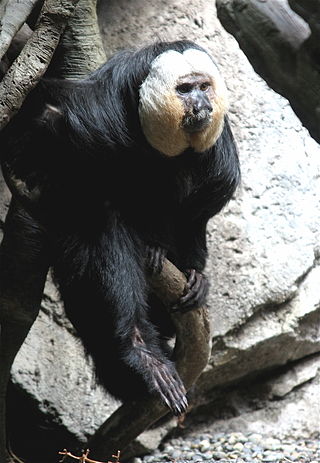
Primates is an order of mammals, which is further divided into the strepsirrhines, which include lemurs, galagos, and lorisids; and the haplorhines, which include tarsiers and simians. Primates arose 85–55 million years ago first from small terrestrial mammals, which adapted for life in tropical forests: many primate characteristics represent adaptations to the challenging environment among tree tops, including large brain sizes, binocular vision, color vision, vocalizations, shoulder girdles allowing a large degree of movement in the upper limbs, and opposable thumbs that enable better grasping and dexterity. Primates range in size from Madame Berthe's mouse lemur, which weighs 30 g (1 oz), to the eastern gorilla, weighing over 200 kg (440 lb). There are 376–524 species of living primates, depending on which classification is used. New primate species continue to be discovered: over 25 species were described in the 2000s, 36 in the 2010s, and six in the 2020s.

Night monkeys, also known as owl monkeys or douroucoulis, are nocturnal New World monkeys of the genus Aotus, the only member of the family Aotidae. The genus comprises eleven species which are found across Panama and much of South America in primary and secondary forests, tropical rainforests and cloud forests up to 2,400 metres (7,900 ft). Night monkeys have large eyes which improve their vision at night, while their ears are mostly hidden, giving them their name Aotus, meaning "earless".

Spider monkeys are New World monkeys belonging to the genus Ateles, part of the subfamily Atelinae, family Atelidae. Like other atelines, they are found in tropical forests of Central and South America, from southern Mexico to Brazil. The genus consists of seven species, all of which are under threat; the brown spider monkey is critically endangered. They are also notable for their ability to be easily bred in captivity.

Robin Ian MacDonald Dunbar is a British biological anthropologist, evolutionary psychologist, and specialist in primate behaviour. Dunbar is professor emeritus of evolutionary psychology of the Social and Evolutionary Neuroscience Research Group in the Department of Experimental Psychology at the University of Oxford. He is best known for formulating Dunbar's number, a measurement of the "cognitive limit to the number of individuals with whom any one person can maintain stable relationships".

Sakis, or saki monkeys, are any of several New World monkeys of the genus Pithecia. They are closely related to the bearded sakis of genus Chiropotes.

The common woolly monkey, brown woolly monkey, or Humboldt's woolly monkey is a woolly monkey from Colombia, Ecuador, Peru, Bolivia, Brazil, and Venezuela. It lives in groups of two to 70 individuals, usually splitting the group into smaller subgroups when active.

The white-bellied spider monkey, also known as the white-fronted or long-haired spider monkey, is an endangered species of spider monkey, a type of New World monkey. It is found in the north-western Amazon in Colombia, Ecuador, Venezuela, Peru and Brazil, ranging as far south as the lower Ucayali River and as far east as the Branco River. In the past, the Peruvian, brown and white-cheeked spider monkeys have been treated as subspecies of A. belzebuth. As presently defined, the white-bellied spider monkey is monotypic. It has a whitish belly and a pale patch on the forehead, which, despite its common name, often is orange-buff, though this might be due to dirt and other stainers. They live in groups of 20 to 40 individuals, splitting into small parties of 1 to 9 when in activity.

The gray woolly monkey or Geoffroy's woolly monkey is a subspecies of the common woolly monkey from South America. It is found in Bolivia, Brazil and Peru. L. l. cana gets its common name, gray woolly monkey, from its thick gray coat. Its hands, feet, face and the inside of the arms are dark in color. The gray woolly monkey has been considered endangered by IUCN since 2008. The subspecies is listed as endangered because it suffered a 50% decrease in population over the past 45 years due to deforestation and hunting.

The silvery woolly monkey, also known as Poeppig's woolly monkey or the red woolly monkey, is a subspecies of the common woolly monkey from South America. Named after the German zoologist Eduard Friedrich Poeppig, it is found in Brazil, Ecuador and Peru.

Tiputini Biodiversity Station (TBS) is a scientific field research center in the Ecuadorian Amazon. It was established in 1995 by Universidad San Francisco de Quito in collaboration with Boston University, and is jointly managed by them as a center of education, research and conservation. A higher diversity of reptiles, amphibians, insects, birds and bats has been found there than anywhere else in South America, and possibly the world. It is located in the province of Orellana, about 280 km ESE from Quito, the capital city of Ecuador. It is located on the northern bank of the Tiputini River, and although separated from the Yasuní National Park by the river, the station forms part of the Yasuní Biosphere Reserve.

Agustín Fuentes is an American primatologist and biological anthropologist at Princeton University and formerly the chair of the Department of Anthropology at the University of Notre Dame. His work focuses largely on human and non-human primate interaction, pathogen transfer, communication, cooperation, and human social evolution.

The Ecuadorian capuchin, or Ecuadorian white-fronted capuchin is a species of gracile capuchin monkey of the family Cebidae. It was formerly classified as a subspecies of the white-fronted capuchin . Mittermeier and Rylands elevated it to a separate species in 2013. The primary physical distinction between C. albifrons and C. aequatorialis is their coloration. Due to low density and distribution researchers have not been able to make a confident molecular genetic assessment of the C. aequatorialis population, but assign it species status based on geographical isolation, morphological characteristics, and the phylogenetic species concept. The location range of the Ecuadorian Capuchin is from Western lowland Ecuador to North West Peru. The conservation status of the Ecuadorian Capuchin was originally near threatened but was revised in 2008 by the IUCN to critically endangered due to the population's rapid decline. Anthropogenic factors such as habitat fragmentation from rapid deforestation, creation of agricultural lands, and persecution from farmers are to blame for the species' critically endangered status.

Josep Call is a Spanish comparative psychologist specializing in primate cognition.

Cebupithecia is an extinct genus of New World monkeys from the Middle Miocene. Its remains have been found at the Konzentrat-Lagerstätte of La Venta in the Honda Group of Colombia. The type species is C. sarmientoi.
Lagonimico is an extinct genus of New World monkeys from the Middle Miocene. Its remains have been found at the Konzentrat-Lagerstätte of La Venta in the Honda Group of Colombia. The type species is Lagonimico conclucatus.
Miocallicebus is an extinct genus of New World monkeys from the Middle Miocene. Its remains have been found at the Konzentrat-Lagerstätte of La Venta in the Honda Group of Colombia. The type species is Miocallicebus villaviejai.
Patasola is an extinct genus of New World monkeys from the Middle Miocene. Its remains have been found at the Konzentrat-Lagerstätte of La Venta in the Honda Group of Colombia. The type species is Patasola magdalenae.

Karen B. Strier is a primatologist. She is a Vilas Research Professor and Irven DeVore professor of Anthropology at the University of Wisconsin–Madison, and co-editor of Annual Review of Anthropology. The main subject of her research is the Northern Muriqui, a type of spider monkey found in Brazil.
Robert M. Seyfarth is an American primatologist and author. With his wife and collaborator Dorothy L. Cheney, he spent years studying the social behavior, communication, and cognition of wild primates in their natural habitat, including more than a decade of field work with baboons in the Okavango Delta of Botswana. Seyfarth, a professor of psychology at the University of Pennsylvania until his retirement, is a member of both the United States National Academy of Sciences and the American Academy of Arts and Sciences.
Lynne A. Isbell is an American ethologist and primatologist, professor of anthropology at the University of California, Davis.















